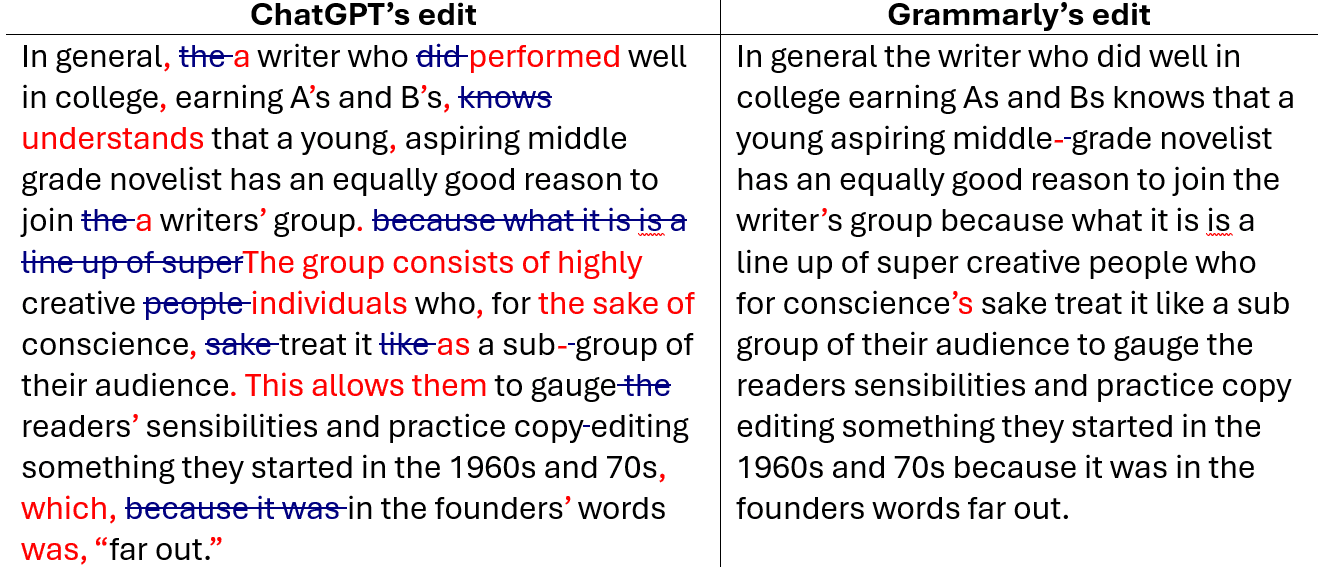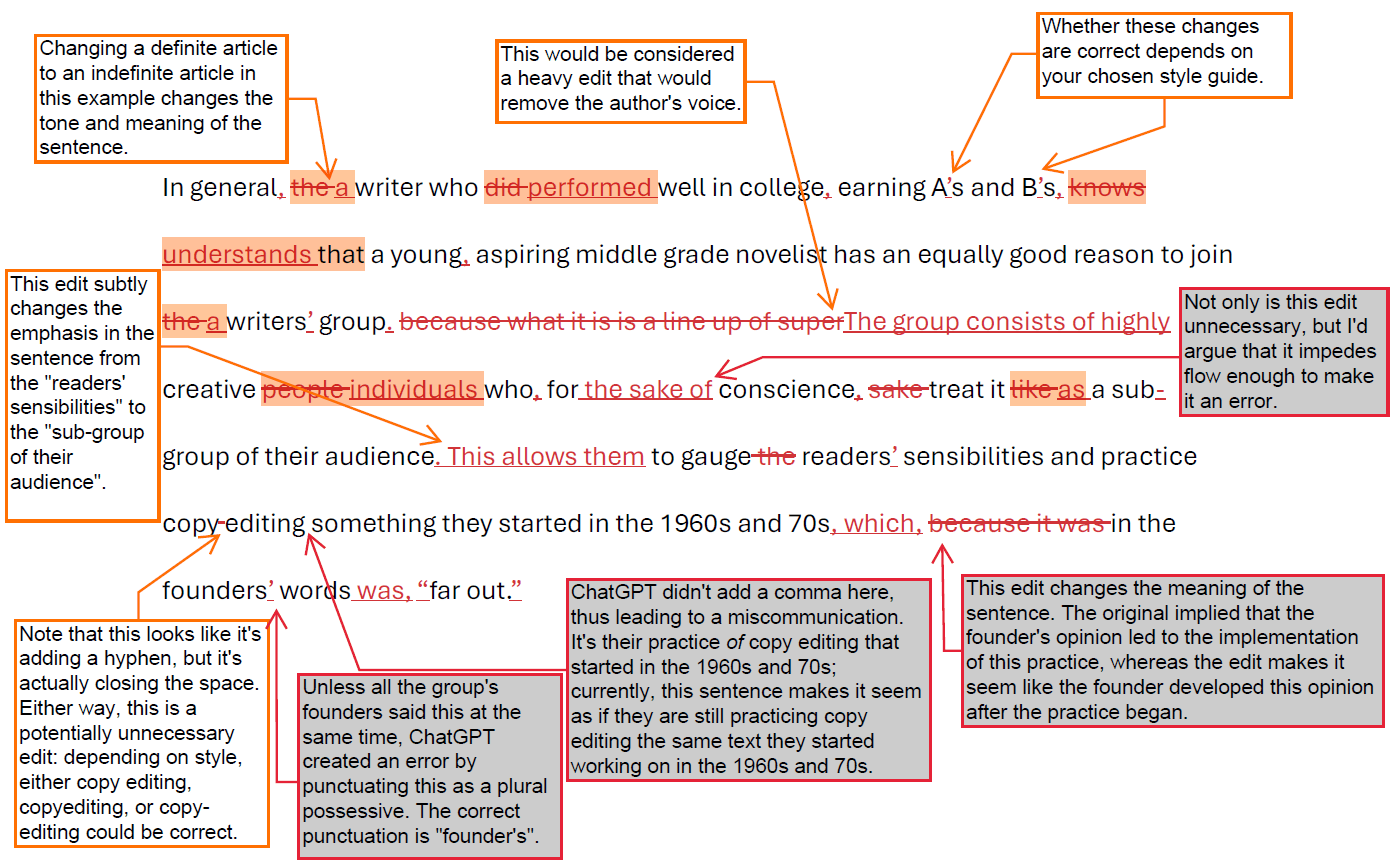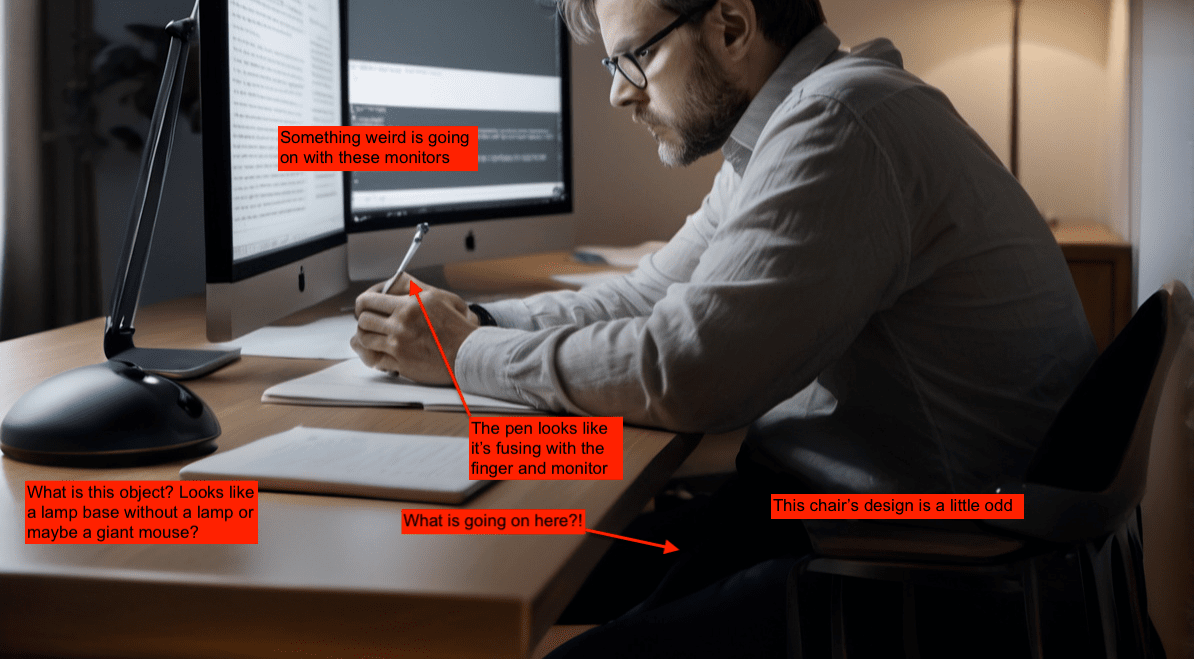AI tools have exploded in popularity, leading many to question the value of working with an editor when software like Grammarly and ChatGPT could, presumably, edit their work at a fraction of the price. So, does the benefit of a human editor outweigh the cost?
Inherent in this question is a misunderstanding of both the rigidity of language and what editing is. Thus, to reach a conclusion, we must understand these concepts.
How to Write Right in English
At its heart, language is agreed-upon rules that humans created to make communication easier. But, while some rules are less flexible than others, they are not set in stone, and can change based on tone, intent, style, region, and audience. Take the following example from June Casagrande’s The Best Punctuation Book, Period:
“In general the writer who did well in college earning As and Bs knows that a young aspiring middle grade novelist has an equally good reason to join the writers group because what it is is a line up of super creative people who for conscience sake treat it like a sub group of their audience to gauge the readers sensibilities and practice copy editing something they started in the 1960s and 70s because it was in the founders words far out.”
In her book, Casagrande provides a solution and breakdown for the many ways this passage could be punctuated. I will not include the solution here, though I highly recommend the book. Instead, to illustrate the flexibility of language and how AI struggles to decipher it, I ran the passage through ChatGPT and Grammarly to see how these programs would edit it.

Grammarly’s recommendations are insufficient, though one could argue that it didn’t do as poorly here as it did in another test, where it scored -9/21 and only made 3 correct suggestions.
Conversely, ChatGPT over-edited the passage, making unnecessary word substitutions that stamp out the author’s voice. That aside, you may think that the more important question is: are ChatGPT’s changes correct? Well, that depends. As Casagrande beautifully points out in her book, punctuation is a matter of style. Depending on the tone, intent, chosen style guide, region, and audience, all of these changes could be fine (except, perhaps, for the unnecessary and annoying word substitutions). In other words, the correctness of these changes depends on both what the communicator intended to say and who they were speaking to.
In the image below, I’ve provided a breakdown of many of ChatGPT’s edits. Unnecessary edits are highlighted in orange, and I’ve added comments to explain some of the detrimental (orange-lined with a white background) or erroneous (red-lined with a grey background) editing decisions it made.

AI tools aim to please by always offering a suggestion, which does not necessarily equate to an improvement.
Baron 2024
AI Introduces Errors
The example above is based on using a very basic prompt: please edit the following text. I’m working under the assumption that the people using AI tools to edit are largely unfamiliar with editing as a profession and may not have the terminology or knowledge necessary to refine the prompt’s wording for their purposes. However, AI’s approach to editing seems to be problematic regardless of attempts to refine prompts. Another editor’s test of Grammarly and ChatGPT reported similarly problematic outputs, and ChatGPT came to very different conclusions based on the prompt used. Moreover, a paper published in Science Editor in 2024 summarized the following issues with using AI to edit:
| Editing Issue | Summary of Issue |
| Grammatical correctness | Because AI does not understand context, it tends to make unnecessary or erroneous changes to definite and indefinite articles and verb tense, and falsely flag “errors” in subject-verb agreement. It’s worth noting that correct article use and verb tense are particularly difficult for non-native English writers. |
| Lost elements | Some AI editors that focus on edits at the sentence level view transition words between sentences as redundant and will simply delete them. |
| Word count limits | After editing a couple hundred words, the paper reported that ChatGPT seems “unable to cope and starts deleting large chunks of text and replacing them with single-sentence summaries”. |
| Consistency | The paper found that none of the AI tools they used could ensure consistency in style choices within a text. |
| Paraphrasing Quotations and Deleting Citations | Some AI editors have a tendency to paraphrase text that was initially quoted. Sometimes, they also delete citations, which could lead to plagiarism issues. |
| Failure to Alert the Author to Unclear or Missing Information | Because human editors can interpret context and intent, they are able to query authors to ensure that text communicates what the author intends it to. Not only did the paper highlight that AI cannot highlight these issues, but putting text through an AI editor will make it harder for a human editor to spot possible instances of miscommunication. |
| Accuracy | Given the point above, it should be no surprise that using an AI to edit can compromise accuracy. However, AI can introduce inaccuracies as well as it can overlook them. We saw at least two examples of this in the example image I provided above, and it’s a persistent issue. The authors of this study suggest using alternative prompts, like “proofread”, to avoid excessive editing that changes meanings, but this can result in under-editing. |
| Author Voice | As demonstrated in my breakdown of ChatGPT’s edits, AI frequently makes unnecessary word and phrasing changes. At best, these are a waste of time to sift through and don’t change the meaning of the sentence. However, in making these needless changes, AI erases an author’s voice. Author voice tends to be more valued outside of academic writing, yet many academic authors still take pride in developing their own style. |
Given that using AI to edit can result in grammatical errors, style inconsistencies, and inaccurate phrasing, preserving an author’s voice may seem like a trivial concern. However, when I asked a group of editors on social media about what they provide their clients that AI cannot, the vast majority mentioned that they are able to preserve an author’s voice. While voice may seem to be an artistic pursuit less fit for academic writing, it’s important to remember that every text, academic or otherwise, is written for a purpose. That purpose may be to convince a reader of the importance of your research, persuade them of a position, caution them against something, or recommend action. Whatever it is, you are more likely to achieve that purpose if your writing speaks for you—if a reader feels like they are listening to someone and can connect with the material in front of them.
Editing is About More Than Grammar
At the beginning of this article, we asked whether the benefit of working with a human editor was worth it when AI tools appear to do a similar job for a fraction of the price. However, as we saw above, the definition of an error often depends on what you are trying to communicate. Thus, the true purpose of editing is to ensure that readers understand the message that the author wants to convey. Generally, high-quality writing will more effectively and accurately communicate your intended message (see here for more on the importance of writing quality). An editor’s goal is, therefore, to increase the quality of your writing and ensure clear communication. We do this by offering feedback based on four different levels of editing: developmental editing, line editing, copy editing, and/or proofreading.
Usually, when we think about working with an editor to improve the quality of writing on the sentence level, we think of line or copy editing. As both the ChatGPT example and academic paper discussed above show, AI can be useful in this area, but it can also introduce grammatical errors and factual inaccuracies, and it often makes unnecessary edits. (See here for more on using AI for copy editing and line editing.) The other two types of editing, developmental editing and proofreading, represent very different levels in the path to publication that are no less important.
Developmental Editing with AI
Developmental editing happens at the start of the publication process, and concerns itself with the big picture of a text, like its overall flow, thematic consistency, and other crucial artistic elements that make something worth reading.
Although you can certainly find AIs (or simply ask ChatGPT) to perform a developmental edit, it simply cannot compare to a human editor, as this writer found with Claude. While she found it a handy tool to help spot developmental issues, she also found that its suggestions were flawed, highlighting “issues” that were intentional parts of the story. As well, when asked to produce a list of characters, the AI created a list made up of any word that started with a capital letter…including those at the beginning of a sentence. This highlights the issue with using AI for editing of any kind, but for developmental editing in particular: AI reaches conclusions based on patterns, without understanding context or being able to interpret a writer’s intent.
Proofreading with AI
At the opposite end of the editing process, proofreading is the last pass given to a text before publication, usually occurring to a document in its final form (e.g., a PDF), that goes through every detail with a fine-toothed comb. This step involves the careful examination of a text to not only identify textual errors that you missed earlier but also ensure consistency and accuracy in its design and layout.
Consider, for a moment, how frequently AI generates images with six fingers, odd dentition, and objects that simply vanish. When we ask AI to proofread, we are putting our money on its ability to understand visual elements. If you’re still skeptical, you can find an example of a professional editor testing ChatGPT’s ability to proofread a single page here. To sum up, ChatGPT made some accurate corrections, claimed to correct errors that did not actually exist, failed to note many of the changes it made, claimed to make changes that it didn’t make, and missed several errors. This is not the only example of AI failing to proofread. In late 2024, all but one member of the editorial board for the Journal of Human Evolution resigned, in part, because Elsevier insisted on using AI in the editing process, resulting in embarrassing errors and wasted time: “AI processing continues to be used and regularly reformats submitted manuscripts to change meaning and formatting and require extensive author and editor oversight during [the] proof stage.”

Editors are Partners, AIs are Tools
Fundamentally, the question of whether AI is a good substitute for a human editor is a misunderstanding of what AI is. AI is a tool. It can be useful in helping you spot errors or improve your writing, but it can also make poor or redundant suggestions that will waste your time and confuse your readers. In this way, though AI is cheap and fast, it cannot replace the knowledge and expertise of a professional editor.
“But,” you may say, “this is only the case for now.” After all, old models are being improved upon, and new models are being released all the time. Given AI’s explosion in popularity and use, this line of thinking is understandable. Yet this prediction could very well be an overextrapolation. Recent headlines claim that AI models have run out of human-generated data to consume and are now using synthetic datasets, which could either work well or create more issues. This, the growing complexity of AI models, and the prohibitive financial and environmental costs associated with developing new models represent significant obstacles in the continued growth of AI sophistication.
Whether or not future AIs can edit as proficiently as a human editor, they may still fall short. Editors do not simply respond to queries and prompts. We can flag issues that you did not think to ask about, offer advice that you would not know to ask, initiate conversations to find the best structure and word choice, and offer encouragement and support throughout the publication process.
Given that AI editing often produces superficially well-written sentences, the editor doing the post-AI checking needs to continually go back and forth between the original and the edited text to spot any infelicitous changes. Some of these may be relatively trivial, but given the nature of scientific research, they have the potential to be disastrous. We have found the task of checking for changes of meaning to be so time consuming that it often eliminates any gains from the initial AI editing.
Baron 2024
